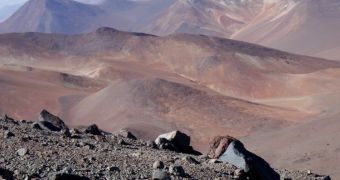While investigating inhospitable soils in the world's most brutal desert, scientists have discovered several new species of bacteria. The microorganisms are at least 5 percent different than anything currently stored in the global database of 2.5 million DNA sequences.
The study was conducted in the Atacama Desert, the driest desert in the world. The area is located in northern Chile, and covers 105,000 square kilometers (40,600 square miles). It has some of the most adverse conditions for life anywhere on the planet, and finding new species here is a rare occurrence.
In fact, conditions here are so severe that some portions of the Atacama are considered to be Mars analogs. The only difference is that the desert is warmer than the surface of the Red Planet. In terms of dryness, the two are nearly identical.
During a new study, experts were able to identify several new species of bacteria, fungi and Achaea living on the slopes of certain volcanoes in the Atacama. The paper is called “The potential for microbial life in the highest elevation (>6000 m.a.s.l.) mineral soils of the Atacama region.”
Details of the work have been accepted for publication in an upcoming issue of the American Geophysical Union's (AGU) Journal of Geophysical Research-Biogeosciences. Scientists say that what enables these organisms to survive here is the manner in which they convert energy.
The approaches they employ are different from what scientists see in other microorganisms around the world. “We haven’t formally identified or characterized the species, but these are very different than anything else that has been cultured,” researcher Ryan Lynch explains.
He holds an appointment as a microbiologist at the University of Colorado in Boulder (UCB), and was one of the scientists who found the new organisms. Experts from CSIRO Ecosystem Sciences, in Australia, and the Museo de Arqueologia de Alta Montana, in Argentina, were also part of the study.
“Overall, there was a good bit lower diversity [in the Atacama samples] than you would find in most soils, including other mountainous mineral soils,” Lynch explains, adding that this is partially why the Atacama microbes are so unusual.
At any other location around the world, precipitations would bring new organisms into the ecosystem. However, this is not the case in the Atacama. “This environment is so restrictive, most of those things that are raining down are killed immediately,” UCB expert Steve K Schmidt explains.
“There’s a huge environmental filter here that’s keeping most of these things from growing,” he adds.
The lack of precipitations at Atacama is the main reason that the world's largest telescopes are located in this hostile environment. The skies above this desert are pristine around the year, with maybe a day or two of clouds annually.

 14 DAY TRIAL //
14 DAY TRIAL //